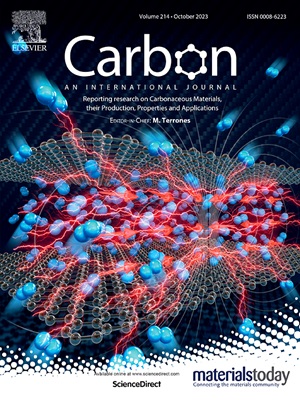Interface engineering optimization: in-situ growth NiZn/carbon aerogel composite for high-performance microwave absorption
IF 10.5
2区 材料科学
Q1 CHEMISTRY, PHYSICAL
引用次数: 0
Abstract
Simultaneously achieving radar-infrared compatibility and multi-environment adaptability in a single material poses significant challenges. By amplifying interface effects, this study proposes a composite carbon aerogel design strategy based on multiscale interface engineering and conductive network reconstruction. This study constructed a 3D hierarchical heterostructures of MOF@aramid fiber-chitosan carbon sheets by inducing in situ directed growth of bimetallic MOF on the surface of aramid fibers via amino ligand, and systematically investigated the synergistic wave-absorption as well as thermal insulation mechanism. The results demonstrate that at a relatively thin thickness, the optimal reflection loss (RLmin) reaches −65.69 [email protected] GHz with a maximum effective absorption bandwidth (EABmax) of 6.32 GHz. Notably, the simulated sample's radar cross-section (RCS) value shows a 24.67 dB m2 reduction compared to the perfect electric conductor (PEC). Furthermore, the samples demonstrated exceptional thermal management capability, hydrophobicity, and corrosion resistance.
界面工程优化:原位生长NiZn/碳气凝胶复合材料用于高性能微波吸收
同时在单一材料中实现雷达-红外兼容性和多环境适应性提出了重大挑战。通过放大界面效应,提出了一种基于多尺度界面工程和导电网络重构的复合碳气凝胶设计策略。本研究通过氨基配体诱导双金属MOF在芳纶纤维表面原位定向生长,构建了MOF@aramid纤维-壳聚糖碳片的三维分层异质结构,并系统研究了其协同吸波和保温机理。结果表明,在较薄的厚度下,最佳反射损耗(RLmin)达到- 65.69 [email protected] GHz,最大有效吸收带宽(EABmax)为6.32 GHz。值得注意的是,与完美电导体(PEC)相比,模拟样品的雷达横截面(RCS)值降低了24.67 dB m2。此外,样品表现出优异的热管理能力,疏水性和耐腐蚀性。
本文章由计算机程序翻译,如有差异,请以英文原文为准。
求助全文
约1分钟内获得全文
求助全文
来源期刊

Carbon
工程技术-材料科学:综合
CiteScore
20.80
自引率
7.30%
发文量
0
审稿时长
23 days
期刊介绍:
The journal Carbon is an international multidisciplinary forum for communicating scientific advances in the field of carbon materials. It reports new findings related to the formation, structure, properties, behaviors, and technological applications of carbons. Carbons are a broad class of ordered or disordered solid phases composed primarily of elemental carbon, including but not limited to carbon black, carbon fibers and filaments, carbon nanotubes, diamond and diamond-like carbon, fullerenes, glassy carbon, graphite, graphene, graphene-oxide, porous carbons, pyrolytic carbon, and other sp2 and non-sp2 hybridized carbon systems. Carbon is the companion title to the open access journal Carbon Trends. Relevant application areas for carbon materials include biology and medicine, catalysis, electronic, optoelectronic, spintronic, high-frequency, and photonic devices, energy storage and conversion systems, environmental applications and water treatment, smart materials and systems, and structural and thermal applications.
 求助内容:
求助内容: 应助结果提醒方式:
应助结果提醒方式:


